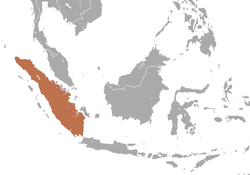| Brooks's dyak fruit bat | |
|---|---|
| Scientific classification | |
| Kingdom: | Animalia |
| Phylum: | Chordata |
| Class: | Mammalia |
| Order: | Chiroptera |
| Family: | Pteropodidae |
| Genus: | Dyacopterus |
| Species: | D. brooksi |
| Binomial name | |
| Dyacopterus brooksi (Thomas, 1920) | |
 | |
| Brooks's dyak fruit bat range | |
Brooks's dyak fruit bat (Dyacopterus brooksi) is a species of megabat in the family Pteropodidae endemic to Sumatra. [1] It was formerly included as a subspecies of the dayak fruit bat. [2] It is named for Cecil Joslin Brooks, who collected the type specimen near Bencoolen and presented it to Oldfield Thomas. [3]
